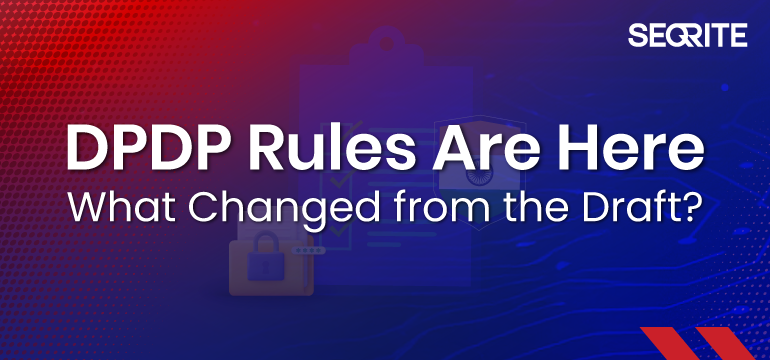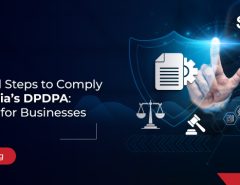India has officially notified the Digital Personal Data Protection (DPDP) Rules, 2025, turning the DPDP Act from a policy framework into an enforceable compliance regime. These rules define how organizations must collect, process, secure, and store personal data, while also clarifying government powers and industry obligations.
With the final version now published, it’s time to examine how the rules have evolved from the draft and what these changes mean for businesses preparing for compliance.
These proposals sparked debate over feasibility, implementation timelines, and the balance between privacy and operational realities. With the final rules now notified, it’s clear which provisions have been tightened, relaxed, or refined.
Recap of the Draft DPDP Rules
When the Ministry of Electronics & Information Technology (MeitY) released the draft rules, they laid out a detailed architecture for data handling:
- Clear consent notices, specifying types of data, purposes of processing, retention limits.
- Mandatory breach reporting (e.g., within 72 hours) and trimming inactive data retention (e.g., three-year limit) for large platforms.
- A framework for “consent managers” to help manage data principals’ (user) consent.
- Special safeguards for children’s personal data (verifiable parental consent, restrictions on profiling).
- Enhanced obligations for “Significant Data Fiduciaries” (SDFs) such as conducting DPIAs, annual audits, and stronger localisation/algorithmic oversight.
These proposals triggered questions regarding implementation feasibility, timelines, and enterprise impact.
Key Changes in the Final DPDP Rules:
The final rules (notified on 14 November 2025) incorporate both continuity and evolution from the draft. Significant modifications include:
Implementation & Roll-out Timeline
- The rules will be applied in phases: specific foundational provisions are adequate immediately, while others kick in after 12 or 18 months.
- For example: registration of Consent Managers takes effect one year from notification; full operational obligations come in 18 months.
Notice & Consent Requirements
- Data Fiduciaries must issue standalone, clearly-worded notices that are independent of other documents. These must include:
- An itemised list of personal data collected.
- Specific purposes of processing.
- A direct link or mechanism to withdraw consent and lodge complaints with the Data Protection Board of India.
Breach Reporting & Security Safeguards
- Entities must notify users immediately in the event of a breach and submit a detailed report to the DPB within 72 hours.
- Minimum data-security measures are delineated, e.g., encryption, masking, tokenisation, strong access control, and log retention for at least one year.
Data Retention, Erasure & Large Platforms
- For traffic logs and processing logs: minimum retention of one year.
- For major platforms (e-commerce, gaming, social media), cross-reference user inactivity: personal data must be erased three years from the last user contact, unless retention is required by law.
- Data Fiduciaries must provide a 48-hour notice ahead of erasure to the user.
Children’s and Vulnerable Persons’ Data
- For processing children’s data (under 18): verifiable parental consent is mandatory; verification can rely on existing identity/age records, voluntary tokens, or recognised Digital Locker service.
- Processing of persons with disabilities: legal-guardian verification as per relevant legislation.
Significant Data Fiduciaries (SDFs)
- SDFs face higher obligations: conducting annual DPIAs and audits, algorithmic transparency, and data-localisation for notified categories.
Governance & Regulatory Bodies
- The Data Protection Board of India is formally established; head office in NCR; comprises a Chairperson plus four members.
- Administrative processes (search-cum-selection committees, service conditions) are specified.
Draft vs Final DPDP Rules: Quick Comparison
| Category | Draft DPDP Rules (Early 2025) | Final DPDP Rules (Nov 2025) |
| Roll-out & Timelines | Timelines not clearly defined; general expectation of phased rollout. | Phased model adopted: some rules effective immediately; Consent Manager registration after 12 months; major compliance obligations after 18 months. |
| Consent & Notice | Clear consent required; flexible formats; notices could be embedded in other documents. | Mandatory standalone notices; must list personal data items collected; must include links for consent withdrawal and complaints. |
| Breach Notification | Mandatory reporting in approx. 72 hours; limited detail on breach communication templates. | Notify users immediately; detailed breach report to DPB within 72 hours; structured elements defined. |
| Security Controls | High-level requirements (reasonable security safeguards). | Explicit baseline: encryption, masking/tokenisation, strong access control, log retention for a minimum of 1 year, mandatory backups. |
| Data Retention & Erasure | Proposed 3-year retention limit for inactive data of large platforms; general retention rules were less detailed. | A 3-year deletion is required; 48 hours’ advance notice is required before erasure; logs must be retained for at least 1 year. |
| Children’s Data | Verifiable parental consent is required; general restrictions apply to profiling. | Specific age verification methods (digital locker, identity records); detailed rules for processing data of children & persons with disabilities. |
| Significant Data Fiduciaries (SDFs) | SDF obligations are outlined but vague, with unclear criteria. | Clear obligations: annual DPIA, annual audit, algorithmic safeguards, and possible localisation for notified categories. |
| Consent Managers | Concept introduced; basic framework defined. | Registration begins after 12 months; operational duties and standards refined; interoperability expectations defined. |
| Cross-Border Transfers | Expected to be restrictive, the mechanism is not clearly defined. | “Black-list” mechanism confirmed: transfers allowed unless a country is notified as restricted. |
| Governance / Regulator | Mention of a Data Protection Board, but the structure is not detailed. | Whole constitution of the Data Protection Board: chairperson + four members, NCR HQ, appointment & service rules defined. |
DPDP Rules Compliance Timeline
| Effective When | What Becomes Applicable | Key Highlights |
| Day 1 (Date of Publication) | Rules 1, 2, 17–21 | Definitions, scope; Data Protection Board formation, functioning, meetings, digital workflows, appointment terms. |
| After 1 Year | Rule 4 | Consent Manager registration rules: Eligibility, Financial Criteria, and Application Process. |
| After 18 Months | Rules 3, 5–16, 22, 23 | Data Principal rights, notices, consent rules (including children/PwD), breach notification, security safeguards, erasure/retention, contact info, SDF obligations, cross-border transfer rules, appeals & govt. info requests. |
What These Changes Mean for Organisations
With the DPDP Rules now final, organisations no longer have room for guesswork. The compliance expectations are clear, implementation paths are defined, and ambiguity regarding interpretation has been largely removed. This shifts the responsibility squarely onto organisations to operationalise privacy, not just document it.
At a practical level, this means:
- Move from policy to execution: Many organisations already have privacy policies, but the rules demand working processes — verifiable consent flows, breach response mechanisms, retention schedules, audit trails, and measurable safeguards.
- Close governance gaps: Organisations must formalise roles, appoint accountable owners, publish contact details, and prepare for regulatory engagement through the Board.
- Rationalise data practices: The rules reinforce disciplined data handling — collect only what is needed, store only for justified durations, erase consistently, and secure data with traceability.
- Prepare for scrutiny: With defined obligations, organisations must assume that decisions, controls, and records may be reviewed by the Board or challenged by Data Principals. Compliance must therefore be defensible, not theoretical.
- Align teams for sustained compliance: DPDP is not an IT-only or legal-only activity. Product, engineering, HR, marketing, customer support, and security teams all need shared awareness and coordinated processes.
Conclusion: The Real Work Begins Now
The notification of the DPDP Rules marks the point at which privacy compliance in India shifts from anticipation to execution. Organisations now have a clear framework, defined timelines, and detailed operational expectations — leaving little room for deferred action. The following 12–18 months will be critical: businesses that proactively strengthen their governance, modernise data-handling practices, and embed privacy into everyday operations will not only meet regulatory requirements but also build deeper trust with customers and stakeholders. The rules are no longer a draft to analyse; they are a mandate to act.
How Seqrite Can Help You Stay Ahead of DPDP Compliance
As organizations navigate the 12–18 month compliance window, Seqrite’s Data Privacy Solution enables a seamless shift from intent to execution. From automated data discovery and classification to verifiable consent management, breach readiness, data governance, and audit-ready reporting, Seqrite offers a unified privacy and security framework tailored to India’s regulatory landscape.
Whether you’re preparing for SDF obligations or building enterprise-wide privacy workflows, Seqrite empowers you to operationalize DPDP compliance with confidence — and build lasting digital trust.




